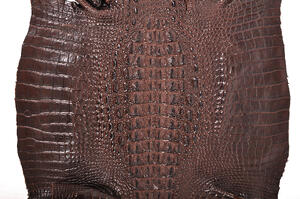 In recent posts, we’ve discussed the use of the crocodilian skins in the manufacture of high-fashion footwear. So far, we’ve covered tips for both caiman crocodile skin and American alligator skin, respectively the lowest and highest end crocodilian hides that are commonly used.
In recent posts, we’ve discussed the use of the crocodilian skins in the manufacture of high-fashion footwear. So far, we’ve covered tips for both caiman crocodile skin and American alligator skin, respectively the lowest and highest end crocodilian hides that are commonly used.
In between these two extremes lies another type of crocodile skin, one that isn’t quite as expensive as American alligator, but is more flexible and of a generally higher quality than caiman skin: Nile crocodile skin.
About Nile Crocodile Hides
Although it is considered the “middle of the road” option between caiman skin and American alligator hide, Nile crocodile skin is a high-end material that is perfect for a number of applications in the fashion industry, including footwear.
Many people, when they think of crocodile leather footwear, their first thought is of cowboy-style boots. While Nile croc hides are certainly useful for boots, their improved flexibility over caiman hides means that they can be useful for other types of footwear as well.
For example, you could use crocodile hide to make athletic footwear, sneakers, or even dress shoes with the right type of finish.
Tips for Buying Nile Crocodile Skins

When buying Nile crocodile hides, keep in mind that the measurement standard for these skins is to measure the center portion of the innermost bones on both sides of the widest point of the crocodile’s belly. Because of this, a 25 to 29 cm size skin is best for smaller pieces of footwear, and a 30 to 34 cm size skin should be used for larger footwear.
As with any crocodilian skin, when planning to make footwear out of Nile crocodile hide, you should plan around making multiple pairs of footwear. One reason for this is that if you were to try to make a single pair of shoes or boots from a single crocodile hide, you would end up using belly or back skin for one part of the pair, and tail skin for the other. This would create an uneven look for that pair of boots or shoes.
Instead, buy skins in pairs so that you can use two bellies or backs for one pair, and two tails for the other. Even if your original plan was only to produce one pair of footwear for a test or demonstration, get two skins so that your final product can have an even look.
For most footwear applications, you don’t need to purchase flawless, grade 1 skins. Instead, you can use grade 2 Nile croc skins if the defects are located in places where they won’t be an issue, such as the top or bottom of the belly or tail. Defects in these areas can be worked around or even trimmed off, so you may be able to save some money by acquiring less expensive, lower-grade skin.
When making your purchase, keeping the unique advantages of the three different kinds of exotic skin sellers can be beneficial:
-
Tanneries- For large, custom orders, tanneries are almost unbeatable. By ordering direct from a tannery, you have the freedom to choose almost any color and finish combination that the hide can take. However, tannery orders take considerable time to process, and on smaller orders, the initial setup costs can lead to a high surcharge.
-
Distributors- When making a small order of commonly-available colors for a short-notice order, distributors are your go-to resource for hides. Since they already have the hides in stock, you typically only have to wait for shipping. However, in order to make money, distributors have to charge a markup, which can quickly outpace tannery setup surcharges on large orders.
-
Manufacturers- Here’s the option that is best for when you don’t want to worry about having to manage the actual production of your footwear. Using the services of a manufacturer not only leaves you free to concentrate on other things, it can help you regulate your expenses by giving you a single invoice to pay as opposed to overseeing labor costs, production facility leasing, and other associated bills yourself. Just take care to make sure that the manufacturer is only ordering skins that they need to complete your order and not wasting your money.
Working with Nile Crocodile Hide
Generally speaking, Nile crocodile hide is easier to work with than caiman hide, but not quite as supple as American alligator hide. With some calcium in the Nile croc hide, however, it can be beneficial to take extra precautions when crafting with Nile hide, such as preparing sewing lines with a dremel or other tool to thin out the skin and make it easier to sew so as not to place too much stress on your sewing equipment.
As mentioned earlier, using two sets of skins to make two pairs of footwear can be beneficial, as it allows you to have matching scale patterns on each individual pair.
When planning for a particular footwear piece, consider the finish of the skin you’ll be using. For cowboy boots and dress shoes, finish processes that leave the hide stiff are great. For sneakers, athletic shoes, and other “everyday” wear items, the skin should be processed using a finish that leaves the hide softer and more flexible. This is one reason why it may be best to order from a tannery, as you can ask the tannery for specific finishes and get advice on what finishes would be best for your footwear application.
Nile crocodile hide is a luxurious, bold material that is perfect for many different types of footwear. Check out our selection of crocodile hides today!



